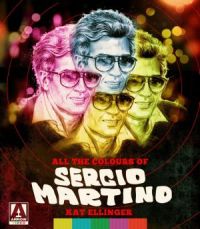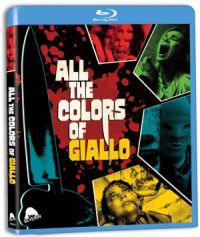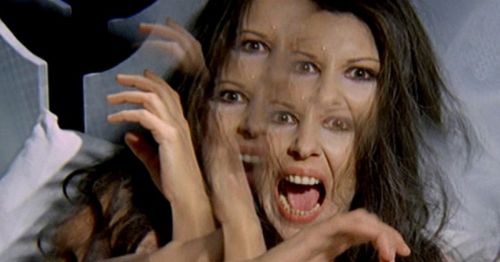
The Many Colours Of Giallo [2019-09-16]Giallo stands as the more flamboyant and arty of horror film sub-genres; and in recent years there has been a growing interest in the sub-genre, with an increasing number of Blu ray reissue of classic, to lessen known films appearing. One of the key and respected commentators on the Giallo genre is Kat Ellinger- over the last few years, she contributed both fact-filled and impassioned commentary tracks and features to a host of Giallo reissues, as writing a book on one the genres key directors Sergio Martino- All the Colors of Sergio Martino. Kat kindly took time out of her busy schedule to give us an email interview.M[m]: When & what was your first introduction to the Giallo genre?
Kat I can’t answer that question definitively because it was such a long time ago! My introduction to Italian genre cinema, in general, came through the Video Nasties scandal in the UK. I was in my teens towards the end of the eighties — the time when I was getting into harder films after having grown up on a diet of Hammer Horror Gothics on BBC2 and heavily cut slashers on video rental — and I got involved with a crowd of punk rockers who were on a mission to secure each and every banned title on the infamous list, and other difficult to find titles. So it was that I spent a large portion of 1989 sitting in a basement bedsit with a crowd of friends, watching as many banned horror films as we could. I kind of want to say the first true Giallo I saw was Dario Argento’s Tenebre, but I can’t be 100% sure.
I do know that in the nineties when I was first exposed to Argento’s Suspiria — not a Giallo, but a film that has gialloesque elements — that I then seriously became enthralled with everything the Eurocult world had to offer; from the lurid art style, the colours, to the amazing soundtracks, and visceral sex and violence. It was at this point I came to understand what a Giallo was and began to actively seek them out.
M[m]: You mention about be rather set in your musical likes/ dislikes- what type of genres do you enjoy?. And as you mentioned early been involved with a group of punks- did you ever land up been part in a band or creating music/ sound yourself?
Kat I wouldn't say I was set in my musical likes/dislikes at all. In fact, the opposite, I don't really stick to 'genres'; a good tune is a good tune. So while I do veer towards heavier stuff like heavy metal and punk, my listening is very eclectic; everything from Satie and Bartok, to current pop music, jazz, reggae, soundtracks. I thrive on novelty so am forever looking for my new favorite album.
I was never part of a band, no. I was always more of an organizer than a doer. My dad is a musician so I was brought up around that world (our kitchen often doubled up as a practice room/ and or recording studio) and we were always being taken off to gigs and such, but I never really got the playing music bug as my brother did. I prefer to just listen and watch.
Way back when though, when I was involved in the punk scene, and living in squats, I did use to get involved in the organizing side, which I still love and can still do in a way through the magazine. Everything was very DIY and done without any technology, and I find that experience comes in very useful when it comes to building up a community around the magazine; connecting with people, networking, etc...

M[m]: What do you think makes the Giallo so fascinating & compelling, and do you also enjoy the slasher genre that it helped spawn?
Kat Again, I don’t think I can give a definitive answer to this because everyone has their own reasons to love the Giallo so I can only tell you my own. But I am generally drawn to the very lurid bright colorful cinema in general anyway — for example, I am a sucker for the grand technicolor epics that came out of classic Hollywood — so the initial thing that drew me in was the work of people like Argento, because he uses heavily stylized color palettes and visuals. Likewise, I am very drawn to that specific time period in European cinema — sixties and seventies — the world of Fellini’s La Dolce Vita, because it’s so cool and cosmopolitan, but then also dangerous and exciting, and somewhat perverse. And of course, this is all turned up to eleven inside the Giallo. So some of it is that: not just what they are, but the specific time and place they represent that can never truly be recaptured ever again because it is gone. It was a time when cinema was rapidly changing and reinventing itself, especially in the genre, becoming more modern, and certainly more permissive and adult as censorship crumbled with the end of the Hays Code in the US as the market opened itself up to new possibilities. I think the Giallo captures the excitement of that period perfectly, and that’s another big reason it is so appealing.
Kat To answer the second part of your question, I do love 80s slashers. I grew up on slashers. I was just the right age to experience slashers around that Golden Age period when everything was new and exciting. I was around ten years old when I started being able to watch this stuff on video, so the slasher thing came at *just* that sweet spot when you are getting all curious and all of a sudden proper adult horror becomes so much more alluring (as opposed to scary). But the Giallo, the Giallo was something else. The Giallo went all the way up that dial-in ways that American cinema couldn’t or wouldn’t. I think that’s why they have such an enduring appeal, at least to me. There’s a definite breaking of boundaries, especially as the cycle went along, where they became more and more violent, more and sexier, and increasingly more perverse at the same time.
However, I don’t think it’s just about surface appeal. That might be what draws you in, but it’s not what keeps you there. At the end of the day, people love to see the dark side of humanity portrayed on screen. The enduring legacy of Hitchcock’s Psycho has proven that — a legacy to which the Giallo owes a large debt. We can’t resist tales of murder and mystery. And, at the end of the day, this is how the Giallo functions. Timeless stories told in contemporary ways. Within the Giallo we find links back to Gothic fiction — with the archetypes of the maiden, and the Byronic hero— there are elements of the traditional mystery — Edgar Wallace, Agatha Christie et al — and in fact the genre takes its name from these old mystery novels, translated into Italian, and put out in a series of yellow covers. These stories have continued to appeal to people for well over one hundred years, so it’s perhaps not so surprising the Giallo does so well when it taps into something that’s already popular, and finds a fresh new way to present those same stories so they feel unique.

M[m]: Do you enjoy any of the more modern takes on Giallo, and if so which particularly stand out to you & why?
Kat I can’t say I do in general. Unlike the slasher which has gone on and on and on reinventing itself, the Giallo is confined to a particular period in history. I have found with the more modern takes they can quite often become nothing more than shallow ‘homages’ to a time that is long gone and can’t ever be truly recreated. I also resent how some filmmakers have attempted to elevate the genre unnecessarily. It was never an elevated art genre, it was popular entertainment made for the masses. That doesn’t mean the Giallo didn’t have its own art, because it did, but if you try and force that then it becomes pretentious. That said, I did really enjoy Astron 6’s The Editor (2015) because it was clearly made with a lot of love for the genre, but not trying to wholly recreate it because in that case, the film was a spoof on Giallo. An incredibly well done one too, with loads of little in-jokes for those who know the genre inside out.
M[m]: In January of last year you released your first book All the Colors of Sergio Martino- discussing the work of versatile Italian director Sergio Martino - who is particularly respected for his Giallo films. Tell us a little bit about what intrigued you most about his work in general, and his take on the Giallo form?
Kat My book on Martino came mainly out of frustration because while he is known for the Giallo, I didn’t believe he got the respect he was due. Often Martino’s gialli films are written about in film criticism within the context of how they emulate or compare to Argento’s. I don’t think this is fair, because the two directors are like chalk and cheese. They share elements common to the genre they both helped shape, but Argento is a genre director; Martino is not. And because of this, their approach to Giallo is completely different.
What I love about Martino’s gialli is the fact they are far more sensual than Argento’s for example. Martino started earlier on, in the late sixties gialli — first producing with his brother Luciano; on things like Umberto Lenzi’s So Sweet… So Perverse — and then making his own version of those earlier films. Unlike the hyper-violent voyeuristic male-centric gialli which became popular because of films like Argento’s The Bird With the Crystal Plumage, these other kinds of Giallo (the ones Martino started out making like The Strange Vice of Mrs. Wardh) have much more in common with the Women’s Films of the 1940s, Gothic melodramas like Gaslight, or Hitchcock’s Rebecca etc… And because I love those original films, there is an obvious draw for me there. In addition to this Martino’s films are heavily sex-positive, especially the ones he made with Edwige Fenech. Unlike the slasher, later on, heroines like Fenech are free to explore their own sexual identities and even perversions and are liberated, not punished because of it. This element comes from the scriptwriter Ernesto Gastaldi, who worked very closely with Martino, and was a writer who was not only emulating the older films I just mentioned — for example the thriller Midnight Lace (1960) starring Doris Day was a big influence on him — but they were also very tuned into the female sexual psyche (it’s perhaps not surprising that Gastalidi was responsible for Mario Bava’s The Whip and the Body; one of the very first films to truly explore female sadomasochistic desire).

Kat Ultimately I think Martino’s status as a journeyman, someone who hopped from genre to genre, gave him an additional edge when it came to making the Giallo. Because each and everyone is different from the others. With The Strange Vice of Mrs. Wardh, he explored sexual perversion through the framework of a melodramatic mystery formula, The Case of the Scorpion’s Tale he changed track and introduced an ensemble cast, intrigue, and jet-set atmosphere. Although All the Colors of the Dark shares a lot in common with Mrs. Wardh, he upped the ante with this one to bring in hallucinatory witchcraft elements — inspired by Rosemary’s Baby — fantasy themes, and an ambiguous supernatural subtext. Then for Your Vice is a Locked Room and Only I Have the Key he goes full Gothic, in his strange adaptation of Edgar Allan Poe’s The Black Cat, as well as examining themes such as marital abuse, incest, and queer sexuality. For Torso he created an early proto-slasher (one that while rarely credited proposed the well-established slasher trope The Final Girl, a full year before Bob Clark’s Black Christmas did). And then he made hybrids like The Suspicious Case of a Minor — poliziotteschi and Giallo — and the much later The Scorpion with Two Tails — Giallo and fantasy horror. He would then go and turn things around full circle in the 90s, when he returned to making more conventional gialli such as his four-part television series Delitti Privatti, or Mozart for a Murder (both of which although made for Italian TV are compelling and highly entertaining).
M[m]: All the Colors of Sergio Martino was released on the publishing arm of Arrow Video- tell us a little bit about how you landed up doing the book for them?
Kat They asked me to pitch something for their book series. I had been wanting to do something on Martino for a while so it seemed like the perfect opportunity.
M[m]: In the last year or so you’ve gone on to do a fair few commentary tracks on various Giallo reissues. You have a real knack of been able to mix together fascinating facts, balanced critic & interesting on-screen observations- making your tracks always something to look forward to. How much planning/ false run-throughs do you do before your satisfied?
Kat Thank you so much, it’s nice to feel my work is appreciated! I think until you actually start doing commentary it’s very easy to assume you just sit there and talk and there’s very little to it. The reality couldn’t be any further from the truth. Generally, even if I am working on a film that I have seen a hundred times, at least 40-60 hours will go into anyone track. That can include anything from watching or rewatching related films, research, notes, etc… I don’t do run-throughs, but I do work from a structured “script” if I am doing solo (I have also done a number of joint tracks, which is kind of easier if you have a partner to bounce off and you can afford to be more chatty and informal), which is more a case of having tightly planned bullet points, rather than writing everything down beforehand (because I think if you do that it can sound a bit too formal and staged, although I know some people are far better at pulling that approach off than me!). I usually record and edit as I go along and then go back in and have a producer re-edit to tighten everything up. It’s a strange type of work and one you have to learn as you go along. So I would say I am still perfecting my method even after 50 tracks.
M[m]: One of the most impressive recent extras you’ve been involved with was your commentary on the over four hours of Giallothron- a chronological collection of Giallo trailers, that appeared on Severin's All The Colors Of Giallo set. How long did it take you to research, work-out, and arranged what you wanted to say for this? And where there any films difficult to discuss?
Kat No, I didn’t find any of them difficult because the guys at Severin put forward such an amazingly tasty array of films to talk about. The only problem was not having enough time to go into all of them as much as I would like because I was confined by the limited time per trailer. I tried to keep it running like a history and hope it worked, so it would add up to a general overview of the genre.
Kat In one way it was easier because I didn’t have to do the type of really nitty-gritty research I do on a singular film. It was all films I knew well so I had no notes, no script, that was all just freeflow riffing off the top of my head. It took a long long time to record though! I didn’t quite appreciate what a mammoth task it would be until I started and realized after a couple I still had another 80 odd to do! I loved doing it though. I was well out of my comfort zone because of the change in format but I love a challenge. And that track, out of all of the others I have done, remains the one I have had the most feedback and messages over. I was inundated with emails and messages and comments on social media (all lovely too!). I really didn’t expect anyone would listen to it all. Boy was I wrong!

M[m]: What do you see as your top ten films from within the Giallo genre, and please explain why they had such an impact?
Kat Hmm, I don’t like to-do lists. I have many favorites and they constantly change depending on what mood I am in. I do tend to swerve towards the more out there gialli I guess. But I don’t think I could offer a complete list. If you ask me next week it will be something else!
I guess I could offer some I return to a lot (in no order):
1. All the Colors of the Dark because I love a good occult story and Edwige is queen.
2. The House with Laughing Windows, because it’s so weird. There’s really nothing else like it. Pupi Avati was a unique talent.
3. Tenebre, because like I said earlier it was one of the first and so will always be close to my heart for that reason.
4. So Sweet...So Perverse, one of the films I think epitomizes that early ultra-cool cosmopolitan look in a Giallo.
5. Blood and Black Lace, because it was one of the first true gialli films and it’s such a bold visual statement done in a way only Mario Bava could.
6. Footsteps on the Moon, again I love those really out there gialli films and this one gets about as far out as you possibly can, and some. Plus it has Klaus Kinski in it as a space commander (kind of).
7. The Perfume of the Lady in Black because it’s like the Giallo version of Roman Polanski’s Repulsion, with Alice in Wonderland quotes as well.
8. Spasmo. Umberto Lenzi’s gialli are also underrated and this one does not get enough love despite being incredibly insane and beautiful to look at too.
9. The Strange Vice of Mrs. Wardh, because it has that wonderful Women’s Film vibe going on, just with S&M.
10. A Lizard in a Woman’s Skin, acid-soaked lesbian tinged psycho-thriller. What’s not to love?
M[m]: As well as all the recognizable visual & plot traits, the Giallo form is known for its soundtracks- who do you see as one of the most accomplished composers of the form? And do you think any composers are often overlooked in their scoring for the genre?
Kat The most obvious and best composers are Ennio Morricone, Bruno Nicolai, Stelvio Cipriani, and then, of course, Goblin for their work with Argento.
But of all of them, Nicolai is probably my favorite and he also scored a bunch of Jess Franco’s best films too. Nicolai and Cipriani were both really exploited in their time because some of their music ended up in the CAM library and would turn up as uncredited stock here there and everywhere, so while the fans appreciate them, I don’t think the industry did and they were both really underpaid as a result.
I really love Alessandro Alessandroni’s soundtrack for The Killer Nun, and I don’t think that gets enough love. It’s a masterpiece but it is unfortunately mainly recognized today for the fact it was reused in Cattet and Forzani’s The Strange Colour of Your Body’s Tears. Nicola Piovani’s track for The Perfume of the Lady in Black is also a flat out masterpiece too. In the case of both these guys, because they weren’t particularly prolific in Giallo film they tend to get overlooked in the wider discussions about genre though.
I am totally the wrong person to ask about music, though. I am a complete philistine and just like what I like.
M[m]: Any plans to write another book about the Giallo genre, or director?
Kat Yes, but if I told you what it was then I would have to put on my black gloves and kill you.
Thanks to Kat for your time and effort with the interview. All the Colors of Sergio Martino is now available from Arrow press books- head here https://arrowfilms.com/product-detail/all-the-colours-of-sergio-martino--arrow-books-/AB006. All The Colors Of Giallo, that features the discussed Giallothron is out on Severin films- and can be brought directly here https://severin-films.com/shop/all-the-colors-of-giallo-bluray/ to find out more. Also, Kat is the editor in Chief/ key contributor over at Diabolique Magazine - where she writes/discussion about all forms of horror cinema- Head here to check out the magazine's web page https://diaboliquemagazine.com,
Picture credits: Still from Tenebre which is available from Arrow Video, Kat Selfie, Cover from All the Colors of Sergio Martino, cover of All The Colours Of Giallo, still from All The Colors Of The Dark which is available from Severin films.
Roger Batty
|

